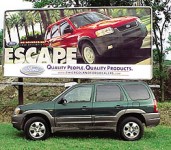At some point between the arrival of our long-term Mazda Tribute on April 10, 2001, and the passage of 13 days, our technical director dented the shiny green tailgate with what he described as “a light push with the flat of my hand.”
This led him to wonder in our logbook of comments on long-term cars just what exactly is the gauge of the steel this small Mazda sport-ute is constructed of, while leading the rest of us on staff to wonder what specifically he meant by “a light push.”
That we mention this incident at all indicates that, light pushing aside, all went well with our long-term Mazda-a near clone of the Ford Escape. If things hadn’t gone so well, we’d have had some terribly damning thing to write about in the lead of this story. It might have started: “If you simply must own a vehicle, the Mazda Tribute is one.” Alternatively, we might have started thusly, “Zoom-zoom? Hell, yes-yes!”
But we didn’t. See, the thing is, after that first two weeks with us, the Tribute racked up miles while drawing little attention to itself. Slowly, the logbook filled with qualified praise, small quibbles, and other unusually sober commentary. A small green sport-ute just doesn’t inspire the logbook poets. As a muse, it stinks.
As a mule, though, it works brilliantly. Staffers might not have quivered with anticipation at the sight of the Tribute, but when it came time for the long-haul trip, with gear, the Tribute was a top choice. We drove it through 25 states and a few Canadian provinces, racking up 40,000 miles in 15 months.
Our Trib arrived in conservative but handsome Jewel Green Metallic, fully pimped out. We’d driven the 130-hp four-cylinder model and decided to pass on that underpowered piece, even though that meant we had to have an automatic transmission. We also decided to get the all-wheel-drive system, because (1) it’s a sport-ute; (2) we live and work in the great frozen north; and (3) without the rear differential in place, there’s a big hole where a rear differential should be and that just looks really wimpy. A full-boat ES model like ours includes cruise control with steering-wheel-mounted controls, 16-inch alloy wheels, a CD player, and leather-trimmed upholstery-all for $23,970. (Mazda raised the base price of the ES V-6 all-wheel-drive model by $485 for 2002.) We optioned our ES with all-weather floor mats (heavy rubber jobs that kept our carpet clean) for $70, a rear-bumper step plate for $89, and the Luxury package for $1090 that has an upgraded stereo and a power sunroof. The grand total of $25,219 was about as expensive as a 2001 Tribute could get.
Of the whopping six recalls that the 2001 Tribute garnered early in its first year of production, none concerned our car. Despite the negative publicity generated by the recalls, the reliability of our Tribute was top-notch. And, we should note, there were no recalls for the 2002 Tributes. We experienced no major, or minor, mechanical problems, although we did have two minor, and mysterious, failings.
Our Tribute required five scheduled service visits. The 7500-, 22,500-, and 37,500-mile services were oil and filter changes. The 15,000-mile service also included a tire rotation. The 30,000-mile service added replacement of the fuel and air filters and various inspections for $128. The other four services averaged $58 each.
The cost of service for 40,000 miles was $360. Compare that with our last long-term small ute, the previous-generation Toyota RAV4, which totaled $481 in regular maintenance plus $64 in repairs.
One of our mysterious quality concerns was the passenger-side window, which popped out of its track at 75 mph with 2200 miles on the odometer, badly startling the driver. It happened again at about 12,000 miles but then created no further problem. At 5672 miles, a series of punctures appeared on the rear seat leather (which incidentally feels a bit more like rubber than animal hide). A thorough investigation indicated that the damage was caused either by canine teeth or some sort of machinery with a sprocket. Predictably, no one fessed up. At about 15,000 miles a creaking noise coming from the tailgate was first noted. At just shy of 20,500 miles, the noise had evolved into “a chorus of squeaks and rattles.” It got no better with time.


Leave a Reply